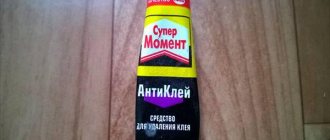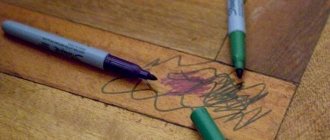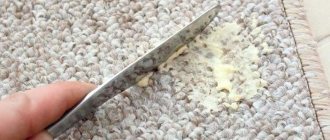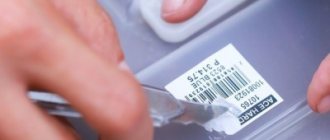Decorative candles create a romantic atmosphere, emphasizing the solemnity of the atmosphere and the peculiarity of the current moment. The only pity is that the beeswax from which this element of holiday decoration is made melts when burned and leaves unaesthetic stains on the tablecloth, and sometimes on clothes. It is quite difficult to get rid of such contaminants, since hot wax instantly saturates the surface of the material and hardens between the fibers. The situation becomes more complicated if droplets of the substance fall on delicate fabrics that cannot be ironed or washed at high temperatures. And yet, there are several remedies that at home will help you completely cope with stains from a melted candle.
Cold and heat against paraffin stains
You can remove particles of substance that have penetrated deep into the material using an iron.
It is easiest to remove wax or paraffin stains from natural fabrics that can withstand ironing and washing at high temperatures. You can consider yourself lucky if a candle drips on your jeans, cotton blouse or wool skirt.
When you see a spreading paraffin stain, you should not fall into despair and panic. We must act quickly and decisively in this situation. Since melted paraffin becomes soft and plastic, you should not try to wipe the drop off with your hand - this can only increase the area of contamination by spreading the stain over the surface of the material. It is better to blot a drop of hot paraffin with a paper napkin, carefully applying it to the fabric, and remove the main part of the substance, not allowing it to be absorbed into the fibers.
Thermal impact
You can remove particles of substance that have penetrated deep into the material using an iron. To do this, place the soiled clothes on the ironing board with the wrong side up, and place a clean paper napkin or white cotton cloth under the stained area.
After heating the iron to the highest possible temperature, the dirty area is carefully ironed through an additional layer of cloth. The wax will begin to melt and be absorbed into the napkins, which will have to be replaced with new ones from time to time. This procedure must be carried out until greasy marks no longer appear on paper napkins.
After all the wax has been removed, all that remains is to remove the greasy stains remaining from contamination. This can be done using stain remover or regular washing powder.
There are some things that should not be ironed at all. For example, a cap or cotton hat is stained with paraffin. In such cases, wardrobe items should be soaked in hot water for a few minutes, then cleaned with a clothes brush and laundry soap.
Freezing
You can get rid of paraffin stains not only by heating, but also by freezing. Each housewife chooses the method that she prefers. The essence of cleaning using low temperatures is as follows. The clothes are packaged in a plastic bag and placed in the freezer for 2 hours. Once the wax is thoroughly frozen, it can be scraped off with the tip of a knife or other sharp object.
How to apply wax according to growth or against it?
Hot wax is applied only in the direction of hair growth, film and polymer wax is applied in the direction of or against the growth of hair. Remove the wax with a sharp tug parallel to the skin. Remove wax in the opposite direction of application. After the procedure, apply lotion with fruit acids to the skin 1-2 times a week.
Interesting materials:
How can you shorten the name Arseny? How can you shorten the name Yana? How can you shorten the name Ulyana? How to write the name Adam in Arabic? How to write an application addressed to the school principal for family reasons? How to learn to remember first and last names? How to stop running as administrator? How is the name Denis translated from Greek? What is the translation of the name Greta? How is the name Karina translated?
How to remove dirt from synthetic material
Many synthetic materials cannot withstand washing with water heated to a temperature of more than 30 ° C, much less ironing with a hot iron. To remove wax stains from such clothes, you will have to call on aggressive chemicals for help: ammonia, ethyl alcohol or turpentine.
Ethanol
A cotton pad or piece of gauze bandage is moistened in a solution of ethyl alcohol and wiped the surface of the fabric in the area of contamination. To prevent the stain from increasing in size, when processing, move from the edge of the stain to the center, and not vice versa. After the bulk of the wax has dissolved, the product can be washed in a machine at the highest possible temperature.
Ammonia
You can get rid of paraffin stains left by melted candles using ammonia. To do this, make a weak solution by combining 1 tbsp. l. alcohol and 1 liter of cold water, and pour it generously over the stain. This method is great for any fabrics that require delicate handling.
Turpentine
This product can remove wax from clothes in just a matter of minutes. To get rid of a fresh stain, just soak a cotton pad in turpentine and lightly rub the stained area. If traces of a candle are not found immediately, you need to apply a swab with turpentine to the stained area and hold it for about half an hour - this is the only way to achieve a positive result.
Detergent
Regular detergent will help remove wax stains.
If you don’t have alcohol or turpentine on hand, you can use any dishwashing detergent to remove wax stains. Apply a little Fairy to the stained area and set the product aside for 10-12 hours, after which it is washed as usual.
All of the above methods allow you to completely get rid of paraffin stains. The main thing is to carry out the cleaning work thoroughly and carefully. If the clothes are not completely cleaned the first time, the procedure must be repeated.
Recommendations
Expert advice will help you deal with wax on clothes and fabrics
- Before using one of the recipes, you must carefully remove the wax blot protruding above the surface.
- A trace of colored paraffin can be treated with undiluted medical alcohol. This is done using a napkin using blotting movements. The work must be carried out carefully so as not to smear the paint even more.
- Fabrics with unstable dyeing deserve special attention. For them, the best option is mechanical cleaning. After removing the top layer of paraffin, talc can be poured onto the stained area and after a while, when it absorbs the dirt, it is removed. The manipulation can be repeated.
- When cleaning wax from upholstered furniture, it is necessary to take into account the composition of the upholstery fabric. As a means of freezing for oversized items, you can use ice cubes placed in a plastic bag.
Useful information about ways to clean wax from various surfaces is in this section.
Removing candle stains depending on the type of fabric
When starting to remove a wax stain, you need to focus on the type of fabric from which the affected clothing is made. While standard products and general rules are suitable for cleaning natural and synthetic materials, fabrics such as suede, velvet, satin or natural fur require special treatment, and knowledge of the various nuances is indispensable.
Suede
To remove melted wax stains from a natural suede jacket, you can use an iron.
- First, the frozen droplet is scraped off with a sharp object: a knife, a thick needle, a toothpick.
- You should act very carefully, trying not to damage the structure of the material.
- Then heat the iron slightly, place it vertically and cover with a clean towel.
- In order to melt the wax, the product is applied to the sole of the iron protected by a towel. If you proceed in the usual way, that is, ironing suede, shiny stripes will appear on the surface of the fabric, which will ruin the appearance of the clothing.
Those wardrobe items that cannot be ironed, such as hats or boots, can be cleaned using a special product. To prepare it you need to mix:
- 45 ml of purified gasoline;
- 10 ml ethyl alcohol;
- 35 ml of ammonia.
A cotton pad soaked in the resulting solution is applied to the contaminated area for several minutes, after which the remaining wax is removed with a clean napkin.
Leather
You can remove traces of paraffin from a leather jacket using steam. In a small saucepan, heat water to boiling point and keep the item over the steam until the wax melts. The remaining greasy trace is washed off with hot water.
Fur
It is not recommended to wash both natural and faux fur in hot water. If a few drops of paraffin get on a fur product, you can get rid of the contamination by freezing it.
- Small items of clothing, such as a collar, hat or detachable cuffs, are frozen in the freezer.
- For bulky items such as a fur coat or coat, you can use pieces of ice.
Frozen wax becomes brittle and, under any mechanical impact, crumbles into small particles that can be easily shaken off the fur fibers by hand or with a clothes brush.
Silk, organza, chiffon, satin
Dishwashing liquid can help remove melted candle stains from delicate fabrics. After the bulk of the paraffin has been removed, a detergent (preferably colorless) is applied to the contaminated area of the material and the item is left for several hours. Finish the stain removal process by washing as usual.
Velvet
When cleaning velvet or velor, you cannot do without organic solvents - turpentine or alcohol. A swab dipped in one of these substances is applied to the site of contamination for 15 minutes, after which the remaining wax is removed with a damp cloth.
Quality requirements
We need to understand the terms. For any wax product, four numbers are determined: acid number, iodine number, ether number and saponification number. What this means is clear from the technology:
- Caustic potassium reacts with fatty acids and esters. Typically, 1 g of wax takes 89-97 mg. This is the saponification number.
- The last number is equal to the sum of the essential number and the acid number.
- The mass of iodine that 1 g of wax will add is the iodine number.
Other properties are also important: physical, etc.
The hardness coefficient can be determined at home - you need a needle with a diameter of 1.5 mm.
"Vika" OGTS-1
However, GOST requires the use of the OGTS-1 installation. Measure the distance to which the needle is immersed in the wax under a force of 1 kgf. The product must be cooled to +20 °C.
The numbers from GOST 21179-2000 are summarized in a table.
| Stationary apiary | Nomadic | |
| Spring steppe forbs | 10-15 kg | – |
| White acacia | 30-35 kg | Up to 80 kg |
| Linden (low-growing) | Same | Same |
| Sainfoin, buckwheat or sunflower | 45-60 kg | 120-130 kg |
The saponification number is not equal to the percentage of esters and acids. It exceeds 100! But there will always be a relationship between both.
How to remove depilatory wax from clothes
Depilatory wax also leaves stains.
Many women use wax for depilation. In addition to paraffin, this cosmetic product contains synthetic and wood resins, as well as various oils. It is difficult to remove stains that appear on clothes due to careless handling of depilatory wax. But there is a proven method that allows you to completely clean your clothes and remove this difficult stain.
Apply a few drops of vegetable oil to the stain and leave the product for 10-15 minutes, allowing the wax to soak in. After this, wash the dirty area with Fairy and place the item in the drum of the machine for further processing.
Professional products for removing wax stains
Sometimes folk remedies do not help completely eliminate pollution. Or, for example, you dropped a candle on a designer item or an expensive fur coat. And it’s scary to remove a stain at home for fear of ruining the item forever. In such cases, turn to professional cleaning.
In addition to improvised means that you can find around the house, you can use effective preparations specifically designed to eliminate this type of contamination.
Products sold for dry cleaning require careful personal protection and a well-ventilated area. Therefore, we advise you to turn to professionals, not to risk your health, the people around you, or the things dear to your heart.
How to prevent sticky marks
It is almost impossible to avoid stickiness during waxing. However, it can be minimized. To do this, you need to follow simple recommendations:
- carefully read the instructions for using wax and follow them strictly;
- grow hair to the desired length;
- distribute wax only over dry skin;
- apply in a thin layer;
- firmly press the strips with the working material to the surface of the skin;
- tear off with a sharp movement;
- immediately remove any remaining mass using post-depilation products.
If paraffin gets on your jeans
Clothes made from denim are popular and loved. Jeans are appropriate for a hike, a walk, or a formal event, so they are always at risk. Dense durable fabric is easy to care for. Cleaning the wax is not difficult. You need to act as follows.
- Apply a few drops of dishwashing gel to the dirty area and rub. Leave for 1 hour.
- Prepare a soap solution by pouring a little washing powder into a container with hot water (+60C). Soak the product for half an hour.
- Wash the item by hand or in a machine.
It is not always possible to remove stains one hundred percent after the first wash. If a trace remains, the procedure must be repeated. To clean jeans from candle wax, the freezing method described above is also suitable.
Wax stains are usually not difficult to deal with. The main thing is to notice the contamination in time and immediately begin cleaning. If clothes with paraffin stains have been lying in the closet for a week, then you can’t hope for a good result. In this case, only dry cleaning will help.










